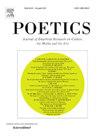Careers in the global art field: Geo-capital and globalizer venues in the consecration of Central-Eastern European artists
IF 1.7
2区 社会学
0 LITERATURE
引用次数: 0
Abstract
In our contemporary art field global institutional networks offer novel strategies for peripheral artists in their struggle for global recognition, bypassing the necessity of maximizing presence in the territorial core. We address the puzzle of how such novel artistic strategies bypassing core gatekeepers can succeed. In this article we analyze the way artists from Central-Eastern Europe strive for consecration via acquisition by the pinnacle museums – Tate Modern, Centre Pompidou and the MoMA – between 1990 and 2018. Our analysis is based on more than hundred thousand exhibition events of about 3500 artists, held at nearly ten thousand venues in 112 countries. We focus on network topology of co-exhibiting relations of venues and artists. We introduce two key concepts to understand success in the multiscalar global art field: geo-capital and the globalizer position. Geo-capital measures the territorial balance of a venue's topological neighbours, capturing a capacity to span boundaries, while the globalizer position marks those venues that can provide artists with global visibility against the territorial core-periphery spectrum on topological grounds. We show that a strategy built on venues in the globalizer position improves the likelihood of consecration more than any other factors. We contribute to prior research by showing the functioning of a relational form of territoriality, that relies on global networks, and provides a mechanism through which global institutional networks can function in relative vertical autonomy within the multiscalar global art field.
在全球艺术领域的职业生涯:中欧和东欧艺术家奉献的地缘资本和全球化场所
在我们的当代艺术领域,全球机构网络为边缘艺术家争取全球认可提供了新的策略,绕过了在地域核心最大化存在的必要性。我们要解决的难题是,这种新颖的艺术策略如何绕过核心把关人取得成功。在本文中,我们分析了1990年至2018年间,中东欧艺术家通过收购顶级博物馆——泰特现代美术馆、蓬皮杜艺术中心和现代艺术博物馆——来争取奉献的方式。我们的分析是基于在112个国家的近一万个场地举办的约3500名艺术家的10多万场展览活动。我们关注的是场馆和艺术家共同参展关系的网络拓扑。我们将引入两个关键概念来理解在多尺度全球艺术领域的成功:地缘资本和全球化者地位。地理资本衡量场地拓扑邻居的地域平衡,捕捉跨越边界的能力,而全球化位置标志着那些可以在拓扑基础上为艺术家提供全球可见性的场地,而不是地域核心-外围频谱。我们表明,建立在全球化位置的场地的战略比任何其他因素都更能提高奉献的可能性。我们通过展示一种依赖于全球网络的关系形式的领土功能,并提供了一种机制,通过这种机制,全球机构网络可以在多标量全球艺术领域内以相对垂直的自治方式发挥作用,从而为先前的研究做出了贡献。
本文章由计算机程序翻译,如有差异,请以英文原文为准。
求助全文
约1分钟内获得全文
求助全文
来源期刊

Poetics
Multiple-
CiteScore
4.00
自引率
16.00%
发文量
77
期刊介绍:
Poetics is an interdisciplinary journal of theoretical and empirical research on culture, the media and the arts. Particularly welcome are papers that make an original contribution to the major disciplines - sociology, psychology, media and communication studies, and economics - within which promising lines of research on culture, media and the arts have been developed.
 求助内容:
求助内容: 应助结果提醒方式:
应助结果提醒方式:


